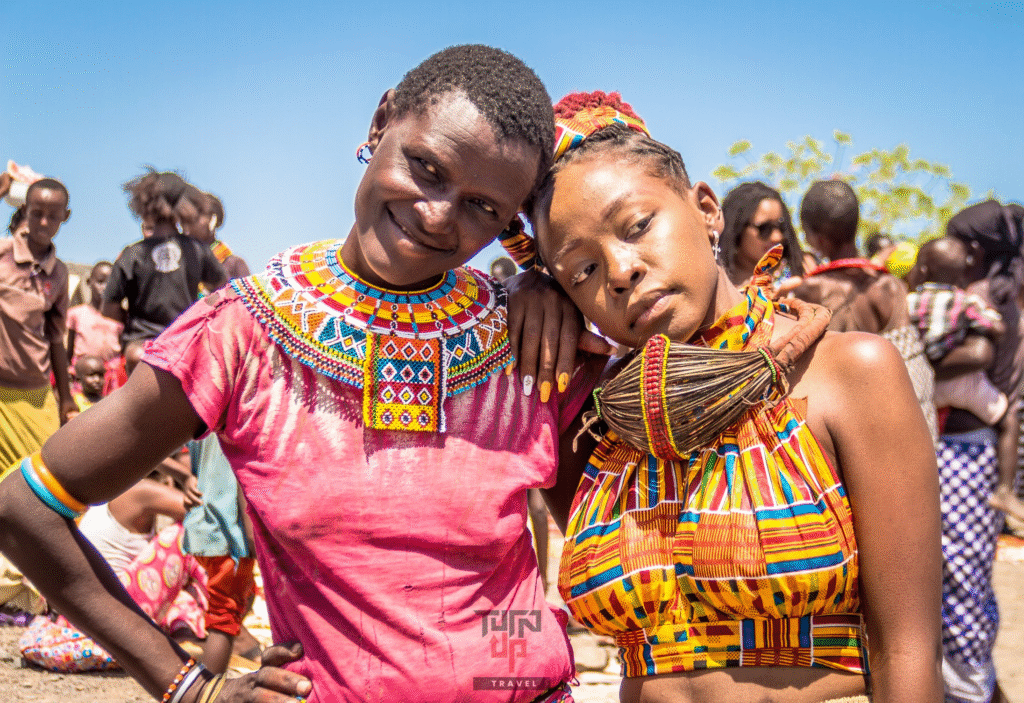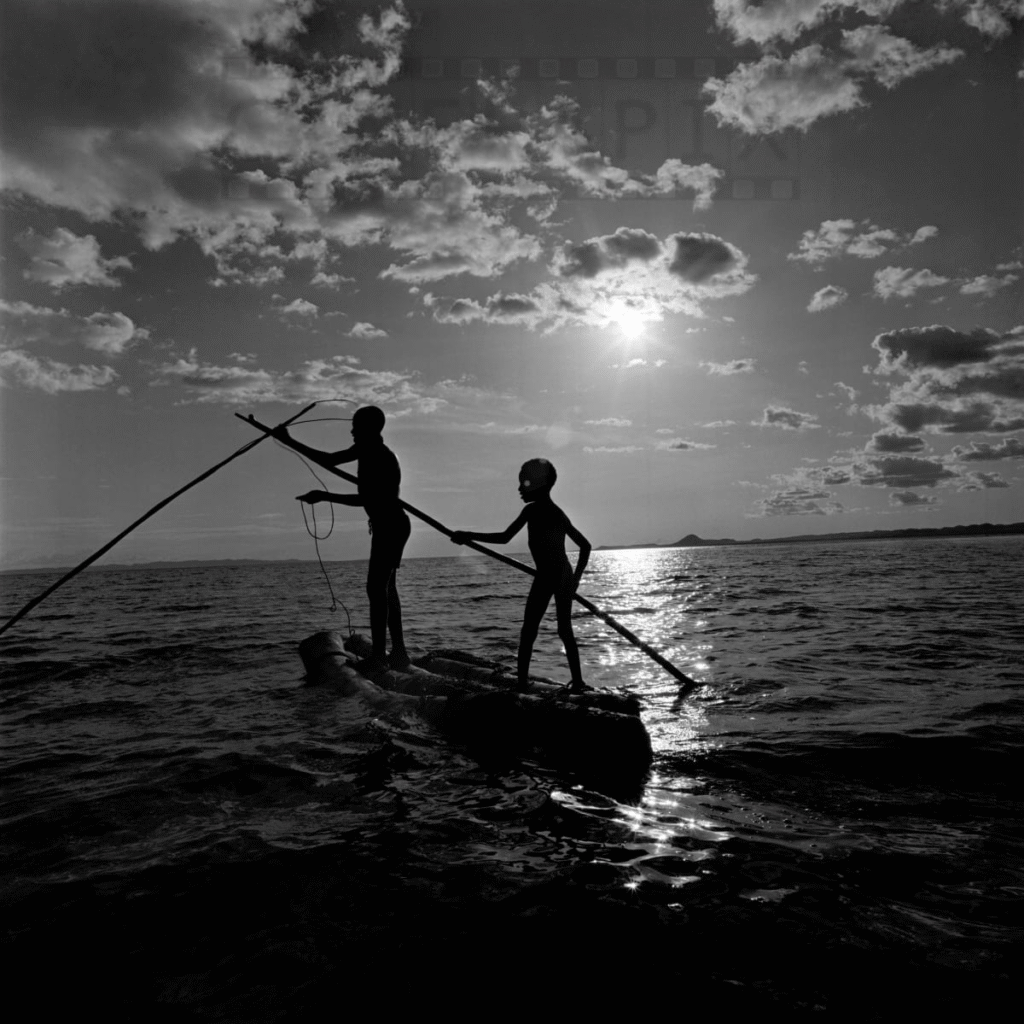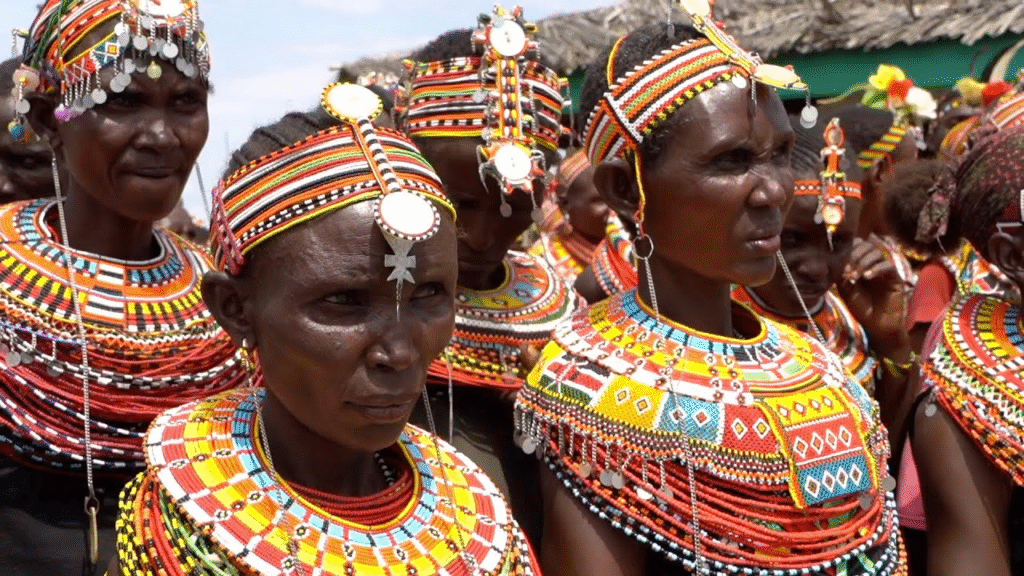By Purity Kiura, Acting Head of Archaeology, National Museums of Kenya
The El-molo is a small community of about 700 people living around El-molo Bay on the southeastern shores of Lake Turkana. El-molo Bay is north of Loiyangalani trading centre, about 600 km northwest of Nairobi.
The El-molo live in two settlements, Komote and Layeni, about 5 km apart. Layeni village lies on an extension of the mainland towards the lake, while Komote lies on a sandspit that runs out from the north shore of what is known as El-molo Bay.
The El-molo today live exclusively in impoverished conditions. They rely on aquatic fauna, especially fish. They also practice traditional customs and still retain much of their culture. The community, therefore, retains aspects of a distant past that today no longer exists. Although these people identify themselves as pure El-molo, their contacts with other tribes in the region, especially the Turkana, Samburu and Rendille, have clearly diluted this identity.
There are no sanctions against marriage outside the group as was the case in the past. Many El-molo women are married off to men from other tribes. Men from outside the tribe can pay the bride price easily. However not many women from other tribes are marrying into the community, as most El-molo men cannot afford the bride wealth.
Count Teleki
The El-molo people were first described to the western world in the late 19th century by the explorers Count Teleki and Lieut von Höhnel during one of their expeditions to Africa. The name El-molo was used by von Höhnel as the name applied to the people of the three surrounding tribes—Gelubba (Dassanech), Samburu and Rendille—who also lived under conditions of extreme privation.
According to Teleki and von Höhnel, the El-molo people relied for the most part on food caught in the lake, though they also acquired some grain by working for the Gelubba during harvest time. Later they were forced to rely totally on food caught from the lake, when the Abyssinians (people from Ethiopia) began to make raids on the Gelubba community and thus cut off the only grain supply to the El-molo people.
The present El-molo people
During my visit with the El-molo people over the month of September 2001, I was surprised to find that the population had risen to almost 700. The majority are young children under the age of 10 years. The people live in huts made from the leaves of the doum palm. The huts are mainly beehive shaped, and are composed of one room (kitchen, bedroom and sitting room). All the family members sleep in this hut with the father and boys to the right side, while the mother and the girls sleep on the left side.

The El-molo people’s resource utilisation strategies are markedly different from those of their neighbours, as they eat primarily fish and occasionally hunt crocodiles and hippopotamus. However, these large animals are rare to find, and thus the El-molos consider them a delicacy. They also value them, as they believe that at one time all the crocodiles and hippos that now live in the lake lived on the land, and were their property. Other food items used by these people are wild fruits that are seasonally available (only after the rainy season).
Birds as food
Birds are readily accepted as food, especially those found along the lakeshore such as pelicans, Egyptian geese, flamingos, and cormorants, as well as a few domestic birds (chickens and ducks) that are kept by some of the villagers. Kingfishers and white herons (egrets) are also common in the area but are considered taboo to eat. These birds are found along the lakeshore where they scavenge on what has been discarded by the fishermen, and also feed on micro-organisms found in the mud along the regressing water edge.
Domestic birds have only been introduced over recent years, and are rarely kept. Those that keep them do so as a means of food for their young children. One old man told us that he had never eaten chicken eggs as he considered them undesirable as a dietary item, and thus always gave them to his son. This however changed when he discovered that we consumed eggs quite often.
During my interviews and observations, I was able to establish that these people rely almost exclusively on fresh or dried fish for their food, although they incorporate other foods that are provided to them by the Kenyan Government through relief agencies, such as yellow maize, beans, soybeans, flour and cooking oil. These items have become important to these people, as they have nothing else with which to supplement their basic diet.

Fishing is normally carried out through harpooning, netting, and hooks on line. In the early days, nets were made from palm string that was twisted, while today they are made from modern nylon thread. It is the work of the men to make and repair these nets, though women are involved once in a while. In the old days, however, it was only the women who were involved with this task.
Species of fish
Different species of fish are caught during different months in the year as they migrate during the annual cycle. For example, during my visit in the month of September, most of the fish caught were Nile perch, catfish, mudfish and tigerfish. There were hardly any tilapia, as this type of fish had migrated to deeper waters. Catfish, squeakers and Nile perch move from inshore to offshore during the high waters (March–June), and then move back inshore over drier months (July–September).

These fish do not like fresh water, which is found at the lakeshore during the rainy season. They therefore migrate to deeper waters. The fish also move into deeper waters to avoid predators, including fishermen. During the rainy season, fishing is mainly carried out in deep waters with the use of nets, although some fishermen can specialise on other fish that are found inshore. These are the cichlids (tilapia), and labeo as they migrate inshore to spawn. Most fish are known to move to deeper waters when the moon is full.
The most common fish all year round are mudfish, catfish and Nile perch. The El-molo use the netting method for most of their fishing, and this method can only be applied in deep waters where these fish are found during their spawning period. The Nile perch is a big fish, which is caught using a hook and this is another popular fishing method with this community.
Netting fish is carried out in phases, with the nets being laid out in the waters during the afternoon and left overnight. Dawn finds the men in the waters ready to net out the overnight catch. The women wait on the shores for the fishing boats, in order to help the men remove the fish from the nets and clean them. When this has been done, the fish are either taken indoors for family consumption or spread out in the sun to dry, ready for the market or storage for future consumption.
The ownership of the fish depends on the group or families involved with each boat and nets. It is conceivable that at times there is a group or family that may not net any fish, and they are provided with fish for their daily consumption by other groups who may be luckier on the day. Ownership of the well-built modern boats is by a group and not individuals.
Ownership of these boats is facilitated by non-governmental organisations for the purpose of commercial fishing. The other form of boat available is the raft, and this may be individually owned. Rafts are made from tree trunks (especially the doum palm). These can only be used in minor fishing activities, as they cannot carry more than two people and can only transport a small load of fish.
Crocodiles and hippos
Crocodiles and hippos are hunted primarily with harpoons, and are normally attacked on land and not in water. Both animals have become rare in the region’s waters.
Most have moved north towards Sibiloi National Park where hunting is not allowed. However, crocodile hunting is carried out more often than hippo hunting as there are still a few crocodiles breeding within the bay. Despite the fact that hippos remain wisely elusive, difficult to find, and even more difficult to spear, the El-molo men form hunting parties and travel up to 70 km north to the hippo breeding grounds.
The clan elders who are veterans of many hippo hunts and the young warriors willing to learn how to carry out the mission of hippo hunting are both engaged in this activity. These hunts can take several days and may yield nothing. Thus the hunting parties may only take place once every two or three years because of poor yields.
For example, during my visit (September 2001), I established that the last hippo hunt to be carried out in the region happened more than 10 years previously. There was also no sign of hippo hunts in the near future even though the community has been given a hippo and crocodile hunting licence by the government to carry out this exercise once a year—but only within other regions of Kenya apart from Lake Turkana.
This is almost impossible for the El-molo as they are poor and live in a very remote region with no means of transportation. They have therefore forgotten about hippo and crocodile hunting, and rely on fish. Once in a while, especially during the rainy period, strong and experienced men pack up their fishing equipment and move further north to an area known as Kandera about 20 km north of Komote village.
Here, fishing is carried out for about two weeks. The fish caught during this time is for both consumption and sale. While the strong and able men are away, a few old and experienced men are left behind to catch fish for the community.
The cooking and preparation of fish for consumption in a family is usually the duty of the mother/wife, though the female children may carry out this duty when the mother is busy or away. The fish can either be smoked or boiled. The smoking of fish is usually carried on outside the hut, while the boiling is done in the hut. Boiled fish is a delicacy, especially for the men who also enjoy the soup.
It is normal for each member of the family to consume on average one fish such as tilapia or mudfish. Nile perch are normally prepared and processed for sale, because they are very large and difficult to catch.
The El-molo still possesses some of the traditional material culture related to food. For example, they use turtle shells as plates and the large bones from Nile perch are used as spoons. They also have cutting tools made from metal. For example, they use large nails to manufacture cutting instruments that are used on fish.
Domestic animals
Domestic animals are rare. Only a few dozen goats, sheep, cows and donkeys that have been acquired recently from the neighbouring tribes are kept. These animals are herded along the lakeshore and sometimes a few hundred metres away from the village. When asked, most of the El-molo value aquatic fauna more than domestic animals. They argue that they only keep domestic animals to economically sustain them, for instance when they need money to send their children to school or hospital.
Although cattle raids are common in the region, the El-molo are never attacked, as they are strategically located on the sand spit. They can therefore spot their enemies before attack, and take refuge on nearby islands. Moreover, they have very few domesticated animals to attract raiders. They believe that any tribe trying to attack them would be cursed, as they are a poor community protected by God.
El-molo dress
Until the early 1900s most of the men were scantily dressed and women wore dresses made from worn-out fishing nets. Today the men are well dressed, with modern trousers or shorts, while the women possess modern garments that have been purchased from traders visiting the region. What distinguishes the El-molo from other groups is their very valuable and distinct ornaments. The women, for example, wear brass or iron wire ornaments round their arms, while small chains of different-sized rings may hang from the lobes of the ears. Beads are sometimes worn round the head, and there are always large numbers of necklaces of ostrich eggshell beads and old-fashioned trade beads hanging in a great mass round the neck like the Samburu.

The men wear either a narrow strip of water-tortoise skin as a tight fitting bracelet, or an ornament made from iron or brass wire in the form of rings on the fingers and a single iron-wire band with scrolled ends round the neck. Very young children (below 10 years) possess few ornaments and no clothing, though they usually boast a string of fish vertebrae round their waist. Older children, on the other hand, have acquired modern dress. This is because a high percentage of children are now enrolled in the primary school near the village, and are required to wear uniforms.
Religion
Religion among the El-molo people is very important and some form of traditional worship and sacrifice is still practised within the community. There are four important shrines in the El-molo community. These shrines were and still are used as places where people visit at different times for prayer and sacrifice. The prayers and sacrifices performed at these shrines have helped to keep peace and harmony among the various clans making up the community, as well as with neighbouring communities. Specific clan members visit these shrines, as different clans are responsible for specific shrines. The shrines are located on an isolated rocky islet between the Layeni and Komote settlements.
Today these shrines are deserted, most likely as a result of the islet becoming an island through rising water levels. Only two of the shrines are functional, though they are also not well taken care of, and most of the items that are used during prayer and sacrifice have been damaged and even misplaced.

Conclusion
The El-molo community is the smallest ethnic group in Kenya. It is in danger of being absorbed into surrounding tribal units, particularly through marriage. In addition, the El-molo are slowly and effectively absorbing western ways and cultural practices from neighbouring tribes. This leads to a loss of their traditions. In the near future, the El-molo community will have no traditional staple food (aquatic fauna), no traditional dress code, no traditional huts and most obviously no customs or traditional culture.
It is therefore important that the community be exposed to ways of preserving their culture, which includes material culture, music and dance. The community’s way of life should also be extensively studied and documented, as not much is known or written about them. Some organisations have embarked on preserving El-molo culture through cultural projects. For example, there is an Italian project whose aim is to build a desert museum at Loiyangalani (together with the National Museums of Kenya). This museum will house some of the material culture from the El-molo community. In addition, there is an awareness campaign for the people in the region on how to organise music and dance performances for tourists.
References
Brenzinger, M (1992), Language Death. Factual and Theoretical Explorations with Special Reference to East Africa. Mouton de Gruyter, New York.
Höhnel, von L (1894), Discovery by Count Teleki of Lakes Rudolf and Stefanie. Longman, Green & Co. London 11: 109–116.
Dyson, WS and Fuchs VE (1937), The Elmolo. Journal of the Royal Anthropological Institute 67: 327–336.
Sobania, N (1988), Fishermen Herders: Subsistence, Survival and Cultural Change in Northern Kenya. Journal of African History 29: 41–56.
Stewart, KM (1989), Fishing sites of north and East Africa in the Late Pleistocene and Holocene. Oxford: BAR International Series 521.
Acknowledgements
I am grateful to Professor J. Harris for providing me with academic advice for graduate studies, which has led to this paper. I also thank the El-molo people for the warm relationship developed over the years while working with them. I thank the National Museums of Kenya and Rutgers University, Anthropology Department for all their support. Financial support for this paper also came from the National Science Foundation, the Leakey Foundation, the British Institute in Eastern Africa, the Holt Family Foundation and the Blanche and Irving Laurie Foundation.
About the Author

Purity Kiura is the Acting Head of the Archaeology Department at the National Museums of Kenya. She is also a co-field director with the Koobi Fora Field School in Palaeoanthropology. She has carried out field research on the diet, culture and economy of the El-molo, the Gabra and the Dassanech in northern Kenya since 2001 as part of her doctorate studies at Rutgers University, USA. She has also worked on intercommunity relationships between the Gabra and the Dassanech. This has helped ease the working relationship between these communities and researchers working within the Koobi Fora Research Area.
